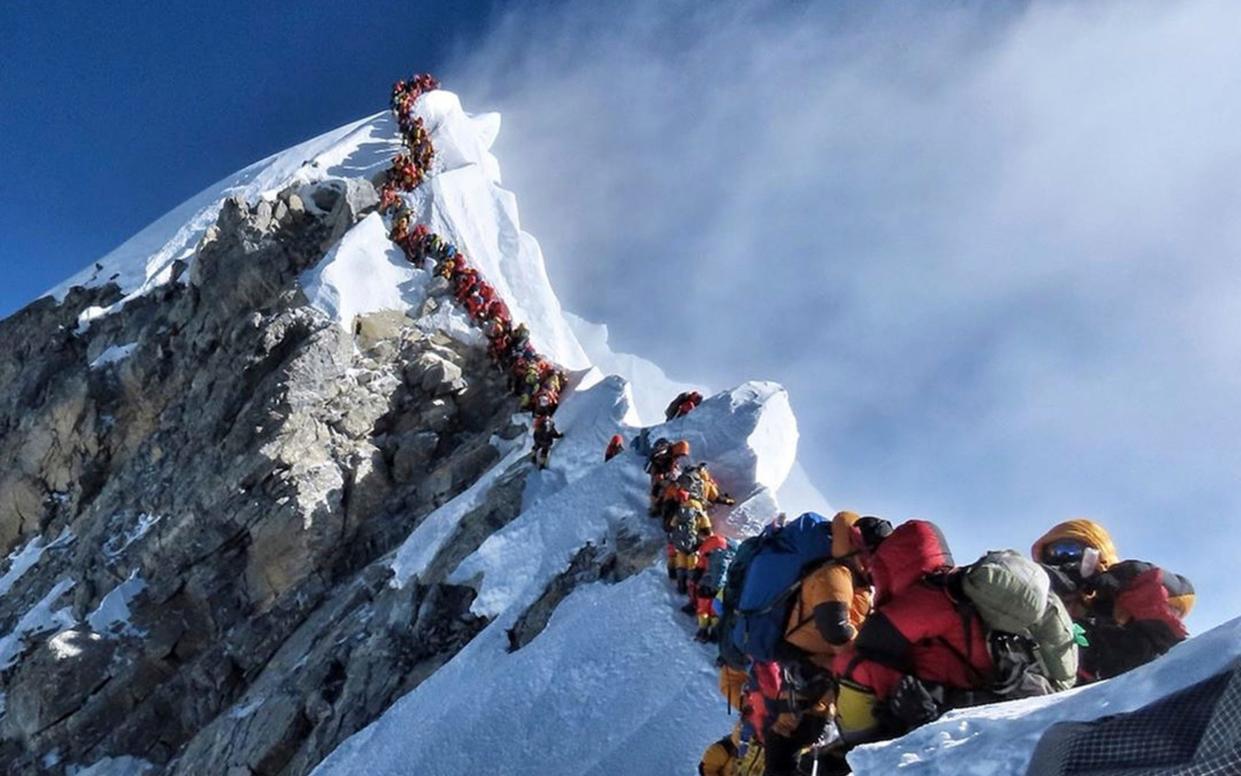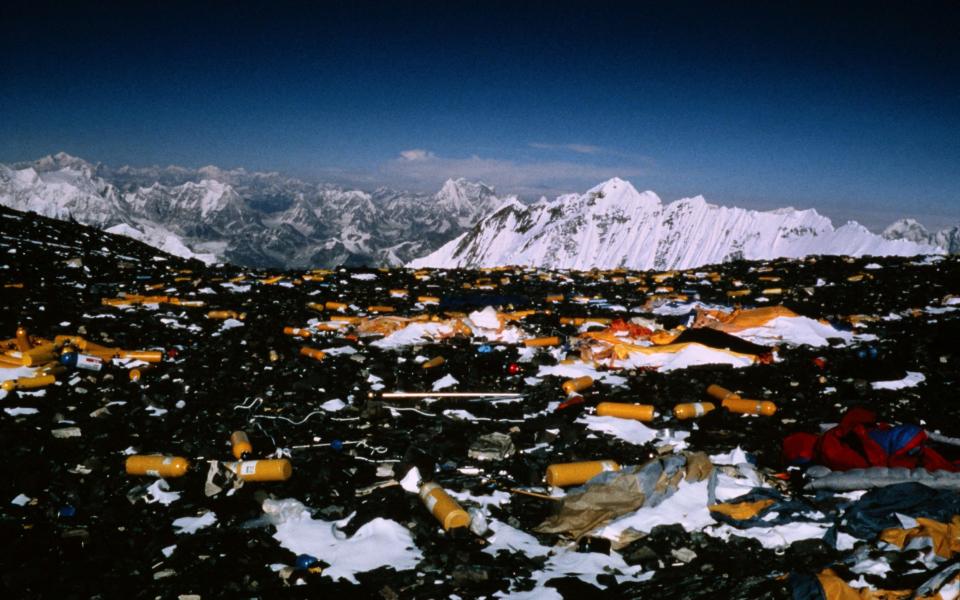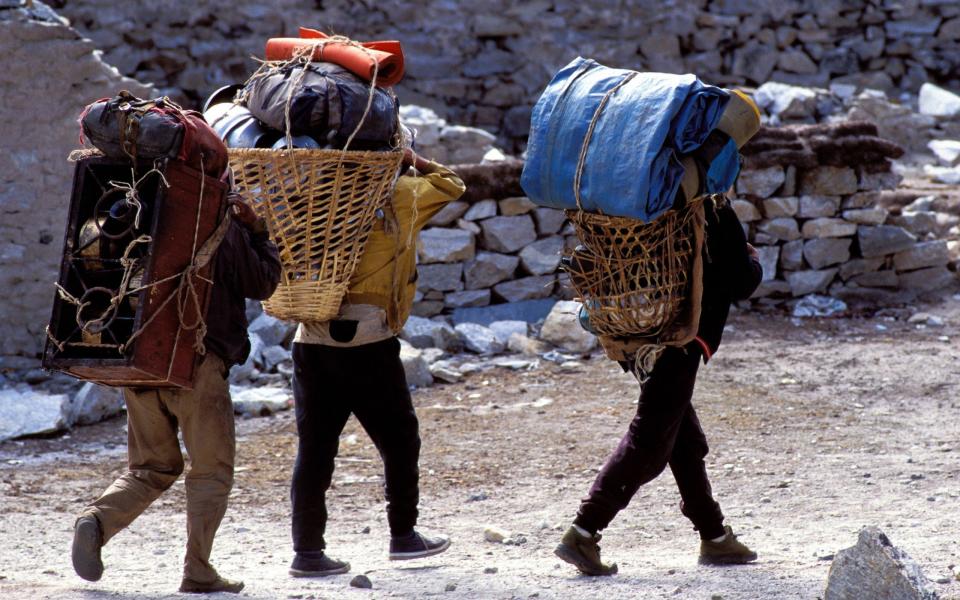Poo bags and GPS trackers among new plans to fix overtourism on Everest

- Oops!Something went wrong.Please try again later.
Once upon a time, climbing Mount Everest – known as Sagarmatha to the Sherpa people of Nepal – was an activity reserved for the world’s top mountaineers. During the decade that followed the first ascent in 1953, only 13 people reached the top of the world’s highest mountain.
Times change. During the 2023 climbing season, more than 600 climbers claimed the summit of Everest, many of them enthusiastic amateurs paying upwards of $55,000 (£44,000) to be guided to the top by expert mountaineers, Sherpa porters and guides. Tragically, the 2023 season also claimed the lives of at least 17 climbers.
Photos of traffic jams in the “death zone” above 8,000 metres and mounds of rubbish at Everest Base Camp have pushed overtourism on the mountain into the headlines, leading many to ask, as teams set out to conquer the mountain this spring, is climbing Everest still sustainable, or even ethical?
In response, the Nepali government has launched a raft of new regulations for climbers in 2024, designed to improve safety and shrink the mountains of rubbish that have grown since Everest was first summited.
This season, as part of the Khumbu Pasang Lhamu Rural Municipality’s Base Camp Management Procedure, the size of climbing groups will be limited to 15 people and all climbers will be required to carry emergency tracking devices.
The new rules also require expeditions to use dedicated shared toilet tents, and anyone proceeding higher than Everest Base Camp will be required to transport their bodily waste down the mountain in a poo bag and carry out at least eight kilograms (almost 18lb) of rubbish at the end of their expedition.
It’s an ambitious move for a mountain that brings in $4.9 million (£3.9 million) in direct revenue from climbing permits every year, but will the new rules really solve Everest’s problems and will they be enforced? Opinions are divided.

“GPS trackers are a step in the right direction,” said Billi Bierling from the Himalayan Database, the organisation that maintains records of summit attempts. “It’s certainly better than not having them, as clients and Sherpas can be quickly located, especially if something happens in the Khumbu Icefall.
“But the best way to make Everest safer is to have more accomplished climbers on the mountain. Every season there is talk about requiring climbers to have previous mountaineering experience, but for some reason it has not yet materialised.”
The introduction of Waste Alleviating Gel (WAG) bags for human waste, however, is undeniably a step forward. According to a campaign by Nepali environmentalist Dawa Steven Sherpa in 2019, climbing expeditions deposit more than eight tons of human waste on the slopes of Everest every year.
“The Sagarmatha Pollution Control Committee (SPCC) will provide a bag to each climber containing a chemical powder that solidifies human waste and makes it odourless,” explains Nima Nuru Sherpa, president of the Nepal Mountaineering Association. “It’s the first time such a rule has been imposed and it will be replicated in other mountains of Nepal.”
Dealing with the problem of equipment and litter left behind by climbing expeditions may be a tougher task. “The rubbish seen in many mountain systems has taken decades to accumulate, and it will take time and effort at all levels to remove,” says record-breaking Nepali mountaineer Nirmal “Nimsdai” Purja, who has led rubbish retrieval teams to Everest, K2 and Manaslu as part of the Big Mountain Clean Up campaign.
According to British mountaineer Kenton Cool, who is currently on the mountain, the authorities need to do more to make sure people understand the responsibilities that come with climbing in the Himalayas. “The biggest change that is needed is education, for both climbers and Sherpas,” he says. “People don’t always know how to conduct themselves in the mountains.
“The Nepali ministry has its heart in the right place, but solving the problems on Everest is not just about announcing rules, but making sure they are understood and followed. The WAG bag is an honourable idea, but there doesn’t seem to be anyone checking. We carried ours down a few days ago, and staff at the SPCC checkpoint had no idea what they were meant to do with them.”

Communication is a big part of the problem, agrees Austrian climber Lukas Furtenbach. “The specific regulations from the Khumbu authority were announced only to Nepalese operators; foreign operators got the news from local partners, rumours and the media.”
To add to the complications, the Khumbu Pasang Lhamu Rural Municipality has already cancelled several of the new rules, including a proposed ban on helicopters transporting supplies to Base Camp (this is now permitted, but only with official permission).
Sherpas have their own concerns about the new regulations. “These rules were announced suddenly and unexpectedly not long before the start of the mountaineering season, and this will have a significant impact on our operational costs,” warns climbing guide Lhakpa Tsheri Sherpa.

“While some think the new rules will generate more employment for local porters and yak herders if fewer helicopters are allowed to transport goods and materials directly to Base Camp, others feel that the new rules will make Everest expeditions even more expensive, which could lead to a downturn in business.”
Climbers are not the only people affected by the changes. More than 90 per cent of the 57,690 visitors to Sagarmatha National Park in 2023 were trekkers, bookending their hikes with hot teas, freshly baked cakes and sometimes even luxury spa treatments in the climbers’ village at Everest Base Camp.
From this year, business ventures at Base Camp will be prohibited, which may mean an end to the camp bakeries and high-altitude massage tents. In future, climbing Everest may be safer and cleaner, but it will also be more austere – for better or worse.

